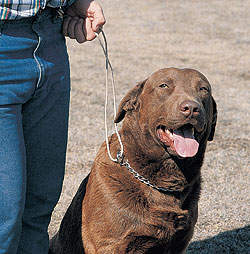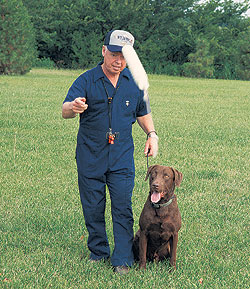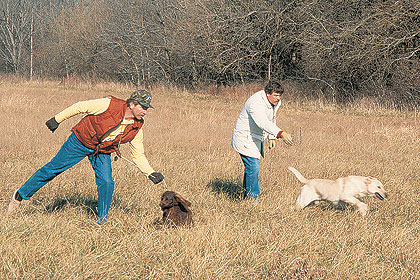By James B. Spencer
 A belt cord attached to the handler's belt and installed on the dog's chain training collar. This type of collar might be necessary for very strong dogs like this Chesapeake, but a strap collar is sufficient for most dogs. |
"Non-slip"? Huh? Like many of our sporting dog terms, we borrowed this one from the Brits, from whom we also borrowed many of our sporting breeds. What we call a "leash" or a "lead" the English often call a "slip." Ergo, a non-slip retriever is a deferential animal that remains at his handler's side, sans restraint, until sent to retrieve.
We Colonists more frequently call such a dog "steady." However, "steady" has other meanings for spanielites and pointing breed aficionados, and consequently for some retrieverites who train their dogs to work the uplands like those breeds. Thus, "non-slip" here limits this column to ways of keeping your beastie willingly at heel until you send him to retrieve. (In spite of such "transparency," I assure you I'm not running for political office!)
Prerequisites
First, you and your pup should be well-bonded, like really good buddies. If you have irreconcilable differences, give that irritating pup to Aunt Minnie and start over with a new prospect. Why waste even one year of your life on a dog that will never please you?
Second, you shouldn't rush into steadying too early in your retriever's career. That can take too much out of the youngster and perhaps ruin, or at least damage, his spirit for life. Instead, wait until he loves to retrieve and is very birdy. In fact, he should be making (unsteady) retrieves in light cover out to your chosen maximum distance, let's say 100 or 150 yards.
Third, he should obey the basic obedience commands, sit, come, heel, and stay.
Otherwise, you would have no control over him, and steadying is all about control.
Fourth, he should understand the command word you use to send him to retrieve. Most retrieverites use their dogs' call names. Blackie! Goldie! Dead-grass! Or whatever. To teach your pooch this command word you should use it every time he takes off to retrieve, from his earliest puppyhood, long before you start steadying him.
This becomes a Pavlovian conditioning process, in which he first learns to associate that word with leaving to retrieve. Then later, when you steady him, he learns that he cannot leave until he hears it. This takes so much of the struggle and frustration out of steadying, for both of you.
Facilities & Equipment
You need three or more large coverless fields, that is, fields with mostly bare ground or clipped grass. You need multiple locations so your dog can generalize this training and not come to think that he must be steady in only one place.
These fields should be coverless so your youngster will always find the bird or dummy.
While it's still in the air, he may struggle so much to get away that he fails to see it come down. In cover, he'd probably fail to find it quite often, which would frustrate and gradually dishearten him. But without cover, he can see the bird or dummy on the ground, so failures simply won't happen. He'll complete every retrieve successfully.
 Tossing a dummy this close really tempts a dog to break. |
You need your normal marking equipment: a thrower (human or electronic), an assortment of dummies and dead birds, a whistle and lanyard, and so on.
Finally, you need a strap collar around your dog's neck and "belt cord" on your belt. A belt cord (see photos) is simply a piece of slender but stout cord about three feet long with a loop on one end. You attach the looped end to your belt and slip the other end under your dog's collar. Then you pull it through eight or 10 inches and double it back on itself. By grasping it where it's doubled back you can control your dog and keep him from breaking.
You should leave slack in your belt cord between your hand and your dog's collar so he feels no restraint -- unless he breaks. Whenever he does break, he almost immediately hits the end of the slack and is yanked back. In his mind, it's magic. He feels nothing unless he breaks, and then some mysterious force jerks him back and holds him in place.
When you release your grip, which you do as you give him his command word to retrieve, he's free to take off and will feel no restraint as he does. Gradually, he learns that your command, and only your command, releases him to go. If he leaves without hearing it, that mysterious force takes over and controls him.
The Process In one of your coverless fields, set up a single mark about 20 yards long, using large white dummies. This short mark allows you to rerun it several times without tiring your pooch. The highly visible white dummies assure success in every retrieve.
Heel your dog to the line (starting point) and slip the end of your belt cord under his collar and double it back so you can grip it firmly. Leave slack in it so he won't feel any restraint until he breaks.
Now signal for a throw. As soon as he sees the dummy in the air, your dog will try to break. Snub him up and force him back into a sitting position beside you. He may twist, turn, leap, and even drag or knock you down so that you and he wind up in a heap. In such a case, he will not see the dummy hit the ground. No matter, for as soon as you set him up sitting beside you at heel, he'll see the big white dummy. Send him with your command word and simultaneously release your grip on the belt cord.
And away he goes! When he delivers the dummy to you, make a big fuss over him. He needs to know that you are highly pleased.
Repeat the process right there several times, but don't let your pooch become tired or bored. Each time he will struggle a little less, but it will be several, perhaps many, sessions before he begins to stop breaking. Change locations for each session, to help him generalize his learning, but stay in coverless fields until he seems to be rock-steady.
 The yellow Lab (working dog) leaves to retrieve, wh ile the American water spaniel (honoring dog) breaks but is restrained by the belt cord. |
After he becomes reasonably cooperative, start using dummies of other sizes and colors, again to help him generalize. Also vary the length of these single marks you set up for him. Stretch them out to your maximum distance. Then shorten them up again until the thrower is right beside you, or even behind you throwing over your head. You'll find these extremely short marks will tempt your youngster to break far more than will the long ones.
Next, switch from dummies to dead birds: Dead pigeons; dead ducks; dead pheasants; whatever you have available. (Most dedicated retrieverites have a freezer full of dead birds at home.) Again, lengthen out and then shorten back up.
Finally, have your thrower (human) start tossing live clip-wing pigeons, that is, pigeons with the flight feathers of one wing removed or taped. These can't fly any distance but they can flutter and run. A flapping, flopping, and running pigeon a few yards in front of your dog in a coverless area will really test his steadiness!
Continue using the belt cord for at least 30 training sessions after you're absolutely positive that you don't need it any longer. Thereafter, when he breaks -- and he will, at least occasionally -- you should correct him with the e-collar, but only after you have e-collar-conditioned him. (For instructions on this, see my books, Retriever Training Drills for Marking and Retriever Training Drills for Blind Retrieves, both available from the Gun Dog Bookshelf.)
Extensions
Obviously, you should extend this work to water. Here, too, start with the belt cord and continue using it for many sessions after you're convince you no longer need it.
Thereafter rely on the e-collar for corrections.
In teaching your retriever to honor, you should start out using the belt cord to control him not only when he's the "honoring dog," (the "honorer") and but also when he's the "working dog" (the "honoree"). The presence of another dog at the line can make him forget all you've taught him about steadiness at the line.
If you decide to teach him to be steady at a distance, where you can't use the belt cord -- like on a dike while you're belly-deep in water hiding in some off-shore cover patch near your decoys -- you should delay this training until he's rock-steady sitting beside you.
Thereafter, you can use the e-collar for any long-distance corrections you might need.
Jim Spencer's books can be ordered from the Gun Dog Bookshelf: Training Retrievers for Marshes & Meadows; Retriever Training Tests; Retriever Training Drills for Marking; Retriever Training Drills for Blind Retrieves; Retriever Hunt Tests; HUP! Training Flushing Spaniels the American Way; and POINT! Training the All-Seasons Bird Dog.






